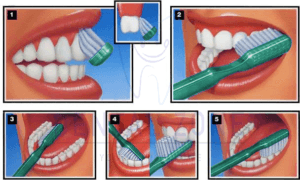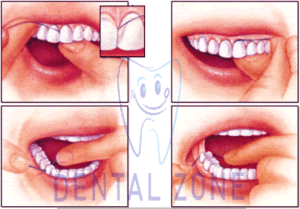The global oral hygiene market reached $ 40.3 billion in 2020. Oral hygiene refers to the practice of maintaining a clean and healthy mouth that is free from disease and other oral problems. Everyone needs to practice oral hygiene regularly to prevent dental problems such as tooth decay, gingivitis, and periodontal disease. Integrate personal dental care routines with products like dental floss, breath fresheners, toothbrushes, toothpaste, and mouthwashes. In addition, oral hygiene also relates to dental services such as the treatment of tooth decay, fluoride treatments, the application of sealants, and the peeling of hardened dental plaque.
On Average Adults between 35-44 lose more teeth from gum disease (periodontitis) than from tooth decay. Three out of four adults are affected at some point in their lives. The best way to prevent tooth decay and periodontal disease is to use good brushing and flossing techniques every day.
Periodontal disease and tooth decay are caused by bacteria in dental plaque. Plaque is a colorless film that adheres to the teeth at the gumline. Plaque is constantly building up on the teeth. By brushing your teeth thoroughly and flossing, you can kill these germs and prevent periodontal disease.
How to Brush Teeth?
If you experience pain while brushing your teeth or have questions about how to brush your teeth properly, call the office on the Dental Zone phone number.

Dr. Suman Reddy and Dr. Keerthi recommend using a soft to the medium-sized toothbrush. Position the brush at a 45-degree angle where the gums and teeth meet. Gently move the brush in circular motions with small, gentle strokes several times as you brush the outer surfaces of your teeth. Apply light pressure while placing the bristles between your teeth, but not too much so that you don’t feel any discomfort. When you are done cleaning the outside surfaces of all of your teeth, follow the same instructions for cleaning the inside of your molars.
To clean the inner surfaces of the upper and lower front teeth, hold the brush vertically. Make several light movements back and forth on each tooth. Be sure to gently brush the surrounding gum tissue.
Then clean the surfaces of your biting teeth with short, gentle movements. Change the position of the brush as often as necessary to reach and clean all surfaces. Try to look at yourself in the mirror to make sure you clean every surface. When you’re done, rinse vigorously to remove plaque that may have loosened from your brushing.
How to Floss?
Periodontal disease usually occurs between the teeth where your toothbrush can’t go. Dental floss is a very effective way to remove plaque from these surfaces. However, it is important to develop a suitable technique. The instructions below will help, but keep in mind that it will take time and practice.

Start with a piece of floss (waxing is easier) that is about 18 inches long. Lightly loop most of the floss around the middle finger of one hand. Wrap the rest of the thread around the middle finger of the other hand.
To clean the upper teeth, hold the floss firmly between the thumb and forefinger of each hand. Gently insert the floss firmly between your teeth using a back and forth motion. Do not force or attempt to floss. Bring the floss to the gumline, then bend it into a C shape against a tooth. Slide it into the space between the gum line and the tooth until you feel a slight resistance. Move the floss up and down the side of a tooth. Remember that there are two tooth surfaces to be cleaned in each tooth gap. Continue to floss on each side of all of your upper teeth.
Be careful not to cut the gums between your teeth. If the thread gets dirty, run from finger to finger to get a new section.
To clean the lower teeth, guide the floss with the index fingers of both hands. Don’t forget the back of the last tooth on the top and bottom.
When you’re done, rinse thoroughly with water to remove plaque and food debris. Don’t worry if your gums bleed or hurt a little during the first week of flossing. If your gums hurt while flossing, you may be flossing too heavily or pinching your gums. If you floss and remove plaque daily, your gums will heal and the bleeding should stop.
Understand the Importance of Dental Care
Caring for Sensitive Teeth
Sometimes the teeth are sensitive to cold and heat after dental treatment. It shouldn’t take long, but only if your mouth is clean. If the mouth is not kept clean, the tenderness persists and can worsen. If your teeth are particularly sensitive, see your doctor. You can recommend a medicated toothpaste or mouthwash that is specifically designed for sensitive teeth.
Choosing Oral Care Products
There are so many products on the market that it can be confusing and it can be difficult to choose between all of them.
These are some of the dental care products that will work for most patients.
High-tech, automatic electronic toothbrushes are safe and effective for most patients. Oral irrigators (water sprayers) will rinse your mouth well, but will not remove the plaque. You’ll need to brush and floss with the conditioner. We’re seeing great results with the Oral-B Vitality 100 and Agaro Cosmic Plus electric toothbrushes.
Some toothbrushes have a rubber tip on the handle that is used to massage the gums after brushing your teeth. There are also small brushes (toothbrushes) that clean between your teeth. If used incorrectly, it can damage your gums, so speak to your doctor about correct use.
Toothpaste and mouthwash containing fluoride can reduce tooth decay by up to 40% when used with brushing and flossing. Remember, these douches are not recommended for children under the age of six. The types of anti-tartar toothpaste reduce tartar above the gum line, but gum disease starts below the gum line, so these products have not been shown to reduce the early stages of gum disease.
Anti-plaque rinses, approved by the American Dental Association, contain active ingredients that can help control early gum disease. Use in conjunction with brushes and floss.
Conclusion
Daily brushing and flossing will keep tartar to a minimum, but professional teeth cleaning will remove tartar from areas that brushing and flossing failed to detect. Your visit to our practice is an important part of your gum disease prevention program. Keep your teeth for a lifetime.
